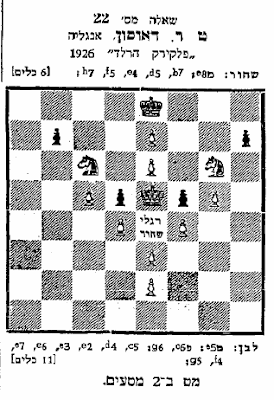 |
| Source: here |
Our frequent correspondent notes that another person who broadcast about chess on the radio was Yochanan Marcuze. For example, Davar (Sept. 7th, 1949, p. 5) reports that he will speak on the radio about 'The heavy pieces -- the queen', while on on Oct. 5th, 1949, Davar reports his show about 'the move 1.d4 - general overview'.
We also add that for a few years, in the 1950s, as we noted before Czerniak had a regular chess column on Israeli radio; e.g., a search for "Czerniak" in the Jewish Press Archives (link in Hebrew) finds his "chess corner" often mentioned, broadcasted at 3PM or 4:30 PM on Friday afternoons, usually for about 20-30 minutes.
We also add that Davar (Feb. 8th, 1951, p. 17 of the weekly supplement) notes that the Israeli chess championship would be followed on the radio, with commentary from the players, every Sunday at 13:45; for example, on the coming sunday (Feb 10th) there will be a talk about the three first rounds and other matters with Dr. Gruengard.
We also add that for a few years, in the 1950s, as we noted before Czerniak had a regular chess column on Israeli radio; e.g., a search for "Czerniak" in the Jewish Press Archives (link in Hebrew) finds his "chess corner" often mentioned, broadcasted at 3PM or 4:30 PM on Friday afternoons, usually for about 20-30 minutes.
We also add that Davar (Feb. 8th, 1951, p. 17 of the weekly supplement) notes that the Israeli chess championship would be followed on the radio, with commentary from the players, every Sunday at 13:45; for example, on the coming sunday (Feb 10th) there will be a talk about the three first rounds and other matters with Dr. Gruengard.











